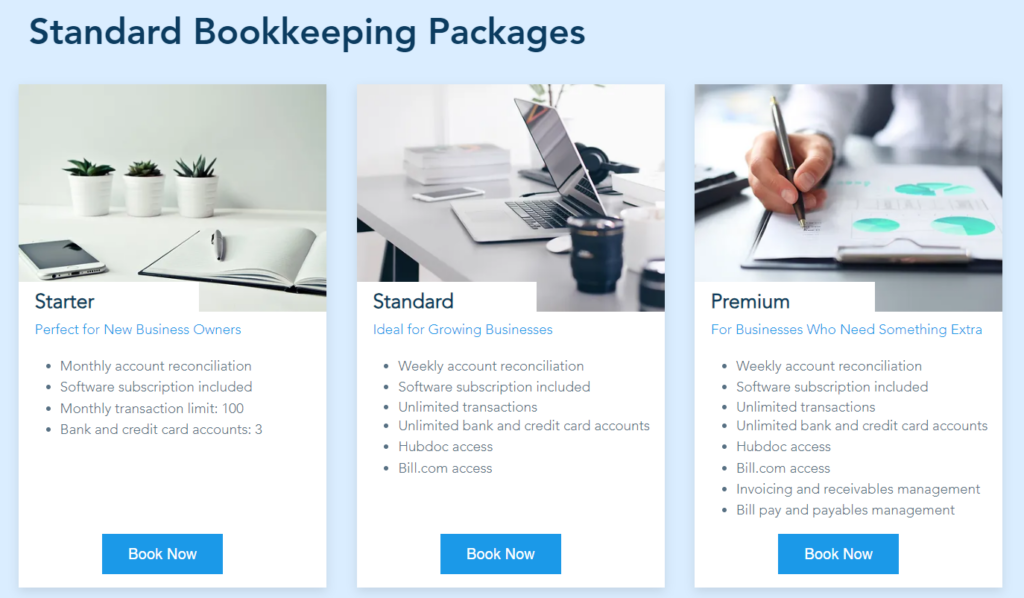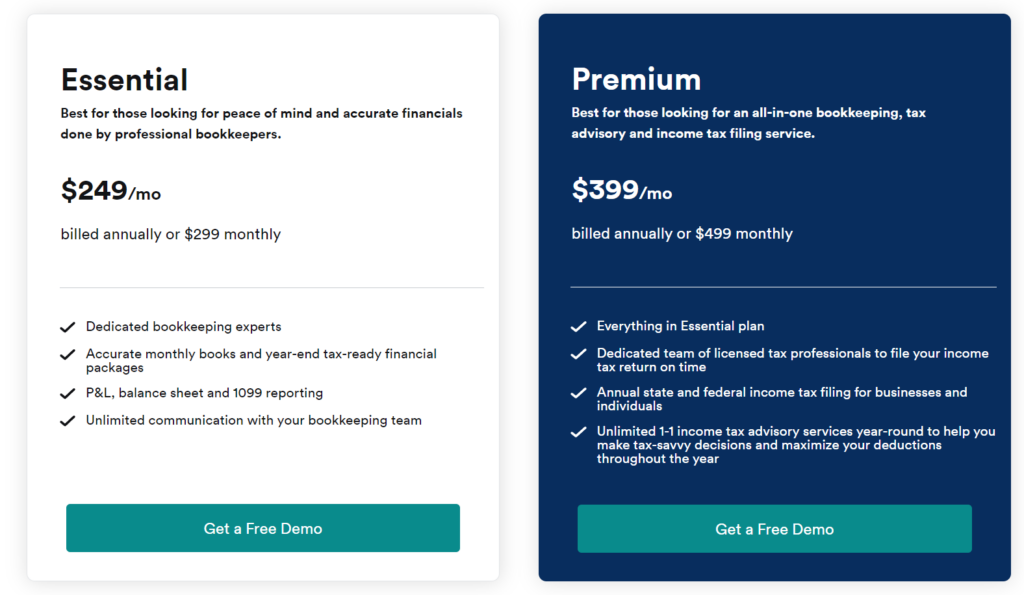How to Package Your Bookkeeping Services [6 Simple Steps]

Packaging your bookkeeping services gives you a focused way to scale and grow your firm. And creating internal processes is easier when you’ve clearly defined your offerings rather than delivering something unique for each client.
However, figuring out how to structure your packages to avoid overcomplicating your service offerings and confusing prospective clients is challenging. You also need to know how to price your packages so you don’t over or undersell the value you’re providing.
Fortunately, we’ve worked with many bookkeeping firm owners who have shared their expert tips and insights on successfully launching service packages to get more clients and boost revenue.
Below, you’ll find the six key steps for packaging your bookkeeping services like the experts. Plus, we’ll offer some helpful guidance on pricing and additional tips for success as you roll out your bookkeeping packages.
Why Package Your Bookkeeping Services?
With uniform service packages, you can keep your workload relatively consistent and manageable no matter what client you’re working on.
Additionally, packaged services can help you be more efficient with your time and money. By creating detailed service packages, you avoid the time and repetition of building custom packages for each client based on their unique needs.
A good approach is to create a few packages for clients to choose from. This streamlines workflows for your team and helps them build their expertise on your core services.
Having different tiers of packages helps clients get the best value for their money rather than paying for services they don’t need.
For just one monthly fee, they can access several bookkeeping services like cash flow forecasts, cost savings recommendations, and greater transparency of their finances.
6 Steps to Packaging Bookkeeping Services
The following steps walk you through how to effectively package your bookkeeping services and create offerings that best fit the needs of your clients and your firm.
Step 1: Work Out Which Services You Can Package
Assess the various bookkeeping services you provide that would work in a package since some may not be suitable. However, analyzing which services clients frequently use or request is a good place to start.
Here are a few examples of the bookkeeping services you may include in a package:
- Basic bookkeeping tasks (e.g., bill pay, reconciling bank accounts, tracking invoices and receipts)
- Tax preparation services
- Financial reporting
- Inventory tracking
- Accounts payable
When considering which services to include in a package, focus on the ones you can standardize for any client.
The reason behind packaging your services is to improve your team’s efficiency and offer more value to your clients, even as you grow your bookkeeping firm. So, choose the services that give you a more streamlined bookkeeping process to gain these advantages at scale.
Step 2: Use Historical Data to Find Billable Hours for Each Service
You can further determine the feasibility of packaging different services together through historical data. Analyze your services and see how many billable hours it typically takes to complete each one.
This data shows how much time your team needs, on average, to complete a given task. It also tells you how much providing the service costs your firm. Resource-intensive tasks may not be best for your bookkeeping packages.
For the services you are considering packaging, use your time-tracking program to calculate the average billable hours spent on each.
This calculation shows the direct cost associated with providing the service. Be sure to account for indirect costs to get a complete picture of the resources needed for each package.
Step 3: Decide on the Different Levels of Packages
Choose a few service package tiers (e.g., Bronze, Silver, and Gold) to fit various types of clients.
As you know from experience, small businesses have very different bookkeeping needs than larger companies or even sole proprietors. By offering a few levels of packages, you can cater to various client segments and their unique needs.
Here’s an example of tiered bookkeeping service packages from Infinity Bookkeepers, ideal for business owners at varying levels:

Consider your clientele and group them based on company size, number of employees, number of monthly transactions, industry requirements, and how complex their finances are. See where the similarities are between the services and level of support you offer each group of clients.
Use your client groupings and billable hour calculations to develop packages your team can manage that cater to these differing segments.
For instance, one option is for every package to include basic bookkeeping tasks and monthly financial reports.
Each higher-tiered package offers additional services or value like priority support, cash flow forecasting, quicker books delivery every month, and customization, which serves the needs of your larger clients.
Take a look at these package options from Bench. The higher tier “Premium” package includes all the services in the “Essential” plan but with additional offerings like tax support and advisory.

Step 4: Write Detailed Descriptions of the Services
Craft detailed descriptions for each of the services you plan to offer in your bookkeeping packages. Break down what’s in each service, including the types of tasks or deliverables you intend to provide.
Avoid being too vague with your descriptions. Use clear, transparent language instead to set better expectations.
These descriptions give you a better idea of the work and effort required for each service and package. They also help you be transparent with clients about what to expect from each service.
From there, you can ensure each package is feasible for you and your team while offering enough value to your clients.
Step 5: Create a Draft Framework of the Package
Now, use all your preparation work to create a detailed framework and structure for each package you present to clients.
Free applications like Trello or Asana can help you develop a visual representation of your packages, detailing their specific services and descriptions and the key deliverables, benefits, and advantages clients get from each one.
Use the service descriptions you created in Step 4 to outline each package. Make sure each framework includes the following details:
- The services in each package
- The tasks/deliverables you provide for each service
- How frequently you provide each service
- Turnaround times
- The level of support you offer with each package (e.g., monthly check-in calls, weekly email updates)
For lower-tier packages, the framework should also briefly list a few services not included for better clarity.
Putting time and effort into this step helps you avoid any confusion, misunderstandings, or frustration about the services clients get when they sign up for a given package.
It also helps your team be more efficient by reducing the time spent answering client questions about a package’s offerings.
Step 6: Test Packages with Select Clients
Before rolling out your new bookkeeping packages to all your clients, select a few to test your packages first. Doing so allows you to iron out any issues in your service delivery and make changes to the package structure if necessary.
Be thorough and find at least one or two clients for every package you plan to offer.
Let clients try the package for a few months at no charge or for a discounted rate in exchange for feedback. Discuss potential pricing with these clients to help you decide the final cost.
If you’re spending too much time on some packages or your clients feel there’s not enough value to warrant the higher price, you may need to do some restructuring so they better fit your team and clientele.
After enough trial and error, you can settle on your final service packages and promote them to the rest of your clients.
Pricing Your Bookkeeping Packages
reating a pricing strategy for these offerings can be intimidating, but it doesn’t have to be. There are a variety of models you can employ to help price your packages, such as:
- Using estimates based on how many billable hours go into delivering each package
- A flat fee based on the perceived value provided to clients at each tier
- Analyzing customer data to determine the average monthly spend for different client sizes
- Custom pricing for larger clients with more complex financials/bookkeeping needs
How you introduce the pricing of your different packages is also critical.
Using pricing psychology and the concept of anchoring, present your highest-priced package first to set the client’s expectations. Then, any package they see at a lower price will look like a good deal.
This process makes it easier to upsell clients to the next-highest tier for better value and convenience.
Whichever approach you take, be sure the prices for each package reflect the work required to deliver each of the included services.
That’s why you need to track time across departments; you want to ensure these offerings are helping your team be more efficient rather than slowing them down.
With a helpful accounting workflow tool like Jetpack Workflow, you can track your team’s progress on client bookkeeping tasks and create convenient checklists for improved productivity.
Our platform gives you better visibility over what your team is working on and prevents crucial items from falling through the cracks.
For a more detailed guide on pricing, our article “How to Price Bookkeeping Services to Maximize Your Revenue” dives into the different variables you should consider to optimize profitability.
5 Tips to Help You Successfully Offer Bookkeeping Packages
Launching your new monthly bookkeeping packages can feel daunting at first.
However, with careful thought and consideration, you can create packages that fit your clients’ needs and ensure a seamless transition to your new service model.
Here are some additional considerations to keep in mind when launching your bookkeeping packages:
- Talk with your clients first to understand what they need and what outcomes are most valuable to them.
- Avoid including services that clients don’t actually need and are unlikely to want in the future. Otherwise, you may have to renegotiate your pricing if clients don’t feel they’re fully taking advantage of all the services included in the package.
- Always send an engagement letter or have the client sign a service agreement before starting work. This way, you avoid misunderstandings about pricing, timelines, and deliverables.
- Create a visual resource using bullet points or check marks to show which services are and aren’t included in your packages.
- Include a cost control service in your packages to help clients manage their expenses and optimize cash flow.





